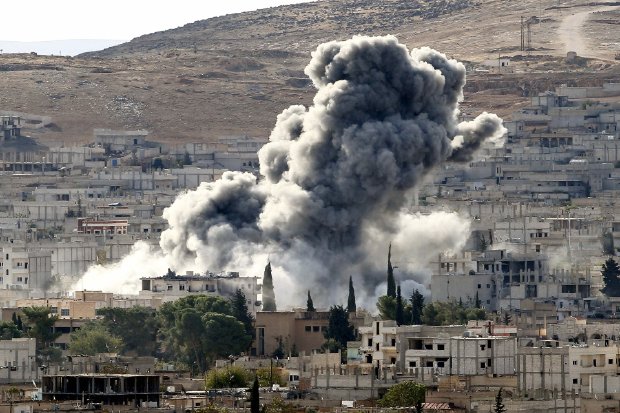Ten Months Later, Still No Strategy on ISIS
WashingtonExaminer.com

Heavy smoke rises
following an airstrike by the US-led coalition
aircraft in Kobani, Syria, during fighting between
Syrian Kurds and the militants of Islamic State
group, as seen from the outskirts of Suruc, on the
Turkey-Syria border, October 15, 2014. (Photo by
Gokhan Sahin/Getty Images)
Speaking Monday at a news conference in Germany, President Obama acknowledged that the United States does not yet have a "complete strategy" for training Iraqi forces to fight Islamic State militants in Iraq.
If that admission sounds familiar it's because Obama said almost the same thing last August when he told White House reporters "We don't have a strategy yet" for defeating the Islamic State.
So, what exactly has the administration been doing for the last 10 months?
We know that the U.S. has been conducting air strikes over both Syria and Iraq. The main result, according to a top State Department official, has been more than 10,000 dead Islamic State fighters.
But that's a dubious claim. With no American troops on the ground to assess death tolls from air strikes, the number of terrorists killed cannot be known. What's more, the administration's emphasis on body counts is eerily evocative of Vietnam, a war in which the number of enemy casualties became the subject of frequent official reports as a measure of military success. In those times, the emphasis on body counts concealed just how badly the war was going in every other respect.
By most other measures, the Islamic State has been flourishing in the time since Obama's first "no strategy" remark. Not only has the terrorist group seen an influx of recruits — including as many as 100 from the U.S. — but it has also made significant territorial gains in both Iraq and Syria.
Last month, its fighters captured Ramadi, the capital of Iraq's largest province. Islamic State militants are currently fighting for control of Iraq's largest oil refinery. In Syria, the Islamic State recently overran the ancient city of Palmyra and is now approaching the doorstep of Aleppo, Syria's largest city.
According to the Syrian Observatory for Human Rights, the Islamic State now rules half of Syria. Another analysis estimates that between Iraq and Syria, it controls 115,000 square miles, a mass of land roughly equal to the size of Italy. Perhaps most significantly, Islamic State controls all of the border crossings between Iraq and Syria.
Obama's neglect of Syria and Iraq seems to confirm Leon Panetta's assessment of him as wanting to keep Iraq out of sight and out of mind from the beginning of his presidency. Panetta served under Obama as CIA director and then secretary of defense. In his memoir, Worthy Fights, Panetta criticized Obama for not doing enough to convince the Iraqi government to accept a residual U.S. force in Iraq when American troops left in 2011.
"Those on our side viewed the White House as so eager to rid itself of Iraq that it was willing to withdraw rather than lock in arrangements that would preserve our influence and interests," Panetta wrote. Obama's lack of commitment in Syria and Iraq, Panetta told USA Today, created a vacuum that led to the Islamic State's rise.
There is an ongoing debate over who's more to blame for the Islamic State and the disintegration of Iraq and Syria — Bush, for invading Iraq, or Obama for abandoning it prematurely. But that debate is largely academic at this point. Obama will have no one but himself to blame if his dithering and lack of coherent strategy turns the Islamic State into a permanent presence on the world map.

